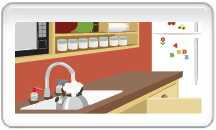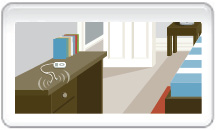Take the virtual house tour
Explore your home to learn how to protect yourself and your family from home health hazards.
Select Area:
Living Room
MEASURE THE RADON LEVEL: Radon is a radioactive gas that naturally accumulates in some houses. It is the second leading cause of lung cancer after smoking. Use a radon long-term detector to measure the level of radon in your home to determine if you need to reduce it. Follow manufacturer's instructions, and place the detector in the lowest level of the home (basement or first floor) where you spend at least four hours a day.
Right

Wrong

BURN CLEANER: Smoke contains several harmful compounds, including carbon monoxide, formaldehyde and small particles you can inhale. Make sure your fireplace is properly installed, inspected and cleaned, and only burn dry untreated wood.
Right

Wrong

WATCH FOR LEAD PAINT: Older houses (pre-1960) may have base coats of lead paint beneath the newer ones. Lead can cause harmful effects if ingested or inhaled as dust. Be careful to avoid raising dust if scraping or sanding old walls or moulding, and test for (and seal) exposed areas of lead paint.
Right

Wrong

HAVE A SMOKE-FREE HOME: Second-hand smoke spreads from one room to another even if the door of the smoking area is closed. Make your home smoke-free.
Right

Wrong

REMOVE OUTDOOR FOOTWEAR: Outdoor footwear can track dirt and contaminants from outside the home into your living environment. Always remove outdoor footwear before entering your home.
Right

Wrong

Kitchen
VENT STEAM: Cooking can release water vapour, increase indoor humidity and lead to mould growth. It can also release air pollutants, such as particulate matter and nitrogen dioxide (NO2) into the home. When using a stove, it is important to have a range hood and fan for venting water vapour and air pollutants to the outside.
Right

Wrong

TEST FOR LEAD: If your home is older and you think you may have lead pipes, get your water tested. If it tests positive, do not use hot water from the tap for cooking or drinking because hot water increases the leaching of lead. Lead in drinking water can cause many harmful health effects, especially to the nervous system, blood system and kidneys.
Right

Wrong

SECURE CHEMICALS: Some household chemicals can cause poisoning. Read the label and follow all instructions for use. Store chemicals in original containers, keep them safely locked away from children, and ask your municipality how to dispose of them safely after use.
Right

Wrong

Bathroom
VENT STEAM: Steam from showering can lead to excessive humidity in the home that may allow mould to grow. Use an exhaust fan or open windows when running a bath or showering.
Right

Wrong

CLEAN MOULD: Leaks can allow water to collect behind walls or under cupboards or floors, providing a damp place for mould to grow. Seal your tubs and sinks tightly.
Right

Wrong

USE CHEMICALS SAFELY: Learn to read and understand common product warning symbols. Carefully read the labels of all household chemicals you buy, including directions for use, harmful interactions with other chemicals, storage, disposal and first aid.
Right

Wrong

Bedroom
TURN IT DOWN: Exposure to loud music or other sounds can cause permanent hearing loss over time. The loudest noise from consumer products comes from personal stereo systems that combine headphones or earphones with portable music players. The players might be radios, or devices that play compact discs, cassettes or stored music files such as MP3 players. If someone a metre away must shout to be understood, the sound levels at your ears may be hazardous. Turn down the volume and limit your exposure to loud noise.
Right

Wrong

VENTILATE FUMES: Some building materials and products can give off gases, such as formaldehyde, that are respiratory irritants. When doing renovations, painting or varnishing, keep the work area well ventilated.
Right

Wrong

REPAIR LEAKS: Water damage can promote the growth of moulds, which are harmful to your health. When there is a leak or water damage, it is important to repair it promptly and to dry the affected area thoroughly.
Right

Wrong

SHORTEN BLIND CORDS: There is a possible strangulation or entanglement hazard for babies and young children who have access to looped or long blind and curtain cords. Cut the cords short when blinds are fully down or when curtains are fully closed or use a clip, clothes pin, or a big twist tie to keep the cord high and out of the reach of children.
Right

Wrong

WATCH PRODUCT RECALLS: Health Canada works with industry and the public to help prevent product-related injuries and to promote safety and the safe use of children's products - stay on top of health risks by checking Health Canada advisories and recalls.
Right

Wrong

GET A CO DETECTOR! Carbon monoxide (CO) is a harmful gas that has no colour, smell or taste. Install a Canadian Standards Association (CSA) certified CO detector with an audible alarm to warn you of high CO concentrations in your home. The most important place to install a detector is in hallways, outside of sleeping areas.
Right

Wrong

Basement
MAINTAIN FURNACE: If not properly maintained or vented to the outside, combustion appliances, like your furnace, can release pollutants such as carbon monoxide - a colourless and odourless gas. Make sure appliances such as furnaces, fireplaces, gas stoves and water heaters are well maintained and inspected by a professional at least once a year. Install a CSA-approved carbon monoxide detector with an audible alarm.
Right

Wrong

REDUCE MOULD GROWTH: Mould growth in a house may cause breathing problems and allergic reactions in some people. It is important to find the source of the humidity that is causing the mould and to correct the problem. A dehumidifier can be a very effective way to reduce indoor humidity levels.
Right

Wrong

REDUCE CLUTTER: Mould can also hide in basement clutter. Remove from the basement cardboard, paper and fabrics on which mould can grow.
Right

Wrong

REDUCE RADON: If the radon level in your home is above the Canadian guideline take steps to reduce it. You can lower the level of radon in your home by sealing cracks in your foundation, putting a sealed cap on your sump hole or by hiring a certified professional to install a radon reduction system.
Right

Wrong

Garage
VENTILATE GARAGE: Exhaust fumes from vehicles contain carbon monoxide (CO), a harmful gas that can penetrate into the house. Never leave a car idling in the garage.
Right

Wrong

KEEP CHEMICALS SEALED: Stored chemicals or fuels can release potentially harmful chemicals into indoor air. It is a good idea to make sure all containers are tightly sealed and stored with other chemical products in an area that is not occupied, such as the garage.
Right

Wrong

STORE CHEMICALS SAFELY: Some household chemicals can cause poisoning. Read the label and follow instructions. Keep chemicals locked out of reach of children. Store chemicals in original containers, and contact your municipality to learn how to dispose of them safely.
Right

Wrong

CLOSE DOORS: Keep adjoining doors from the garage to your home closed. Car exhaust contains CO and can enter your home through joining doors or cracks in the wall.
Right

Wrong

- Date modified: